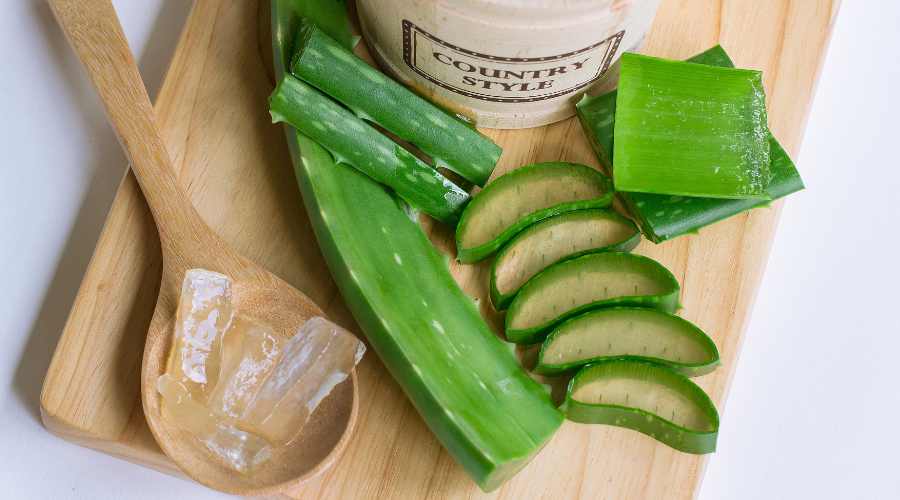DIY Lube: Homemade, All-Natural & Free from Harmful Chemicals
Are you looking for a natural DIY lube?
You can use aloe vera as lube. Aloe vera makes an excellent DIY lube because of its hydrating properties and gentle touch. This makes it an excellent choice.
As a certified organic skincare formulator, I recommend using fresh aloe vera gel straight from the plant for the most soothing, natural lube.
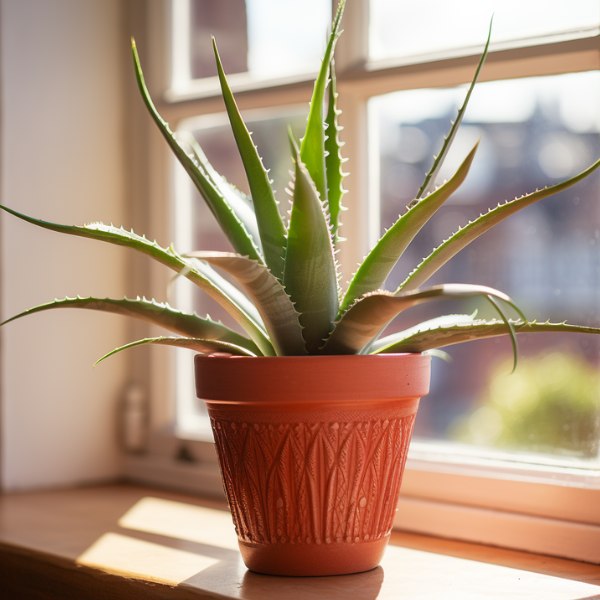
For a very simple aloe vera lube DIY, here are the instructions:
- Cut open an aloe vera leaf and scoop out the clear inner gel. Avoid the yellow sap near the skin, which can be irritating.
- Blend or whisk the gel for 3-5 minutes until smooth and strain through a sieve to remove any fibrous pieces.
- Transfer the fresh aloe gel into an airtight container and store it in the fridge for up to 4 days.
- Use as-is as an organic, hydrating personal lubricant.
If you prefer to buy pre-made aloe vera gel rather than extracting it fresh, make sure to get 100% pure inner leaf gel with no additives.
Always opt for a commercially formulated product specifically designed for intimate use. Here is my recommendation (I may earn a commission if you purchase from my link).
I always seek the perfect, natural touch in my self-care.
In crafting my skincare, I choose simple, pure ingredients that feel right and work well.
Aloe vera, in my opinion, is the ideal botanical lubricant – straight from the plant for an organic, therapeutic experience.
Learn to Make Your Own Homemade DIY Lube
I’m going to teach you how to make your own DIY aloe vera lube, ensuring it’s not only effective but also safe and gentle for your body and using ingredients you can trust.
My article below aims to provide an easy-to-follow guide on making your own aloe vera lube at home.
Keep reading if you are curious how this all-natural substitute could revolutionise your intimate moments!
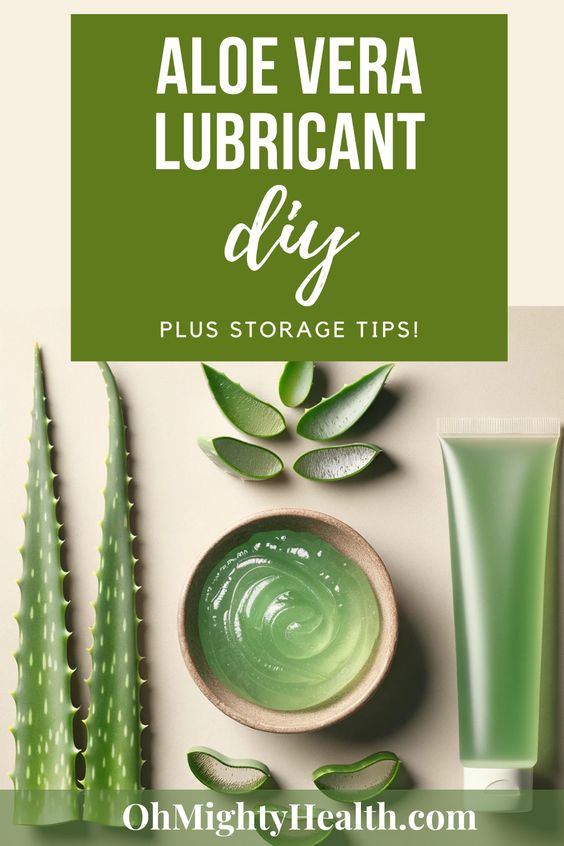
Aloe Vera Lube DIY Personal Lubricant – Key Takeaways
- Natural Alternative: Aloe Vera lube offers a natural, chemical-free alternative to store-bought lubricants, eliminating concerns about harmful additives and potential irritations. Using aloevera gel as lube provides a safe and natural option, especially appealing to those sensitive to synthetic ingredients or who prefer a more holistic approach to personal care. This would particularly appeal to those sensitive to synthetic ingredients or who prefer a more holistic approach to personal care.
- Aloin Removal: It’s essential to remove aloin, a potentially irritating substance found in the outer leaf of the aloe vera plant, before using the gel for intimate purposes. Don’t worry, it’s very easy!
- Preparation and Storage: The DIY lube can be easily prepared using fresh aloe vera gel and optional oils like Vitamin E or Jojoba (not to be used with latex condoms). Once made, it should be stored in the refrigerator and used within 3-4 days for optimal freshness. Although this DIY project requires some work, the result is a personalised and natural product that aligns with your health and wellness values.
- Compatibility and Safety: If using condoms, it’s crucial to ensure the DIY lube is compatible, especially if oils are added, as some oils can degrade latex. Aloe vera gel, being water based, is generally safe to use with most types of condoms, reducing the risk of any adverse reactions. A patch test is recommended before intimate use to check for allergic reactions.
- Preservation Tips: To extend the shelf life of the DIY lube, store it in the fridge, use clean utensils, and store in airtight containers (photos below). Regularly check its consistency and smell; always label the container with the preparation date. Remember, you’ll want to make small batches to ensure the lube doesn’t spoil!
IMPORTANT:
✔ For vaginal sex, aloe vera gel can be a suitable lubricant. It aligns with the vagina’s normal pH (3.8 to 4.5) and is unlikely to cause infection or irritation. It should be avoided when trying to conceive due to its lower pH compared to the higher pH needed during ovulation.
❌ For anal sex aloe vera is not recommended because its pH of about 4.5 doesn’t match the rectum’s pH of 7 to 8. Also, its thinner consistency provides less cushioning, increasing the risk of injury.
How to Make the DIY Lubricant
Crafting your own Aloe Vera lube provides a natural and skin-friendly alternative to many store-bought options. By preparing it at home, you can know each ingredient, ensuring a bespoke and trusted blend.
It is really easy to learn how to make your aloe vera lubricant.
Here’s my Tik Tok video on how to make it, step by step.
@ohmightyhealth How to make aloe vera DIY lube step by step #aloelube #diylube #aloeveralube #aloeveragel ♬ original sound – Patri 🤗
Ingredients
Aloe Vera Gel
You can extract the gel directly from the leaves if you have an aloe vera plant. If not, you can purchase pure aloe vera gel from health stores or online. Ensure that it’s 100% pure and free from additives, alcohol, and artificial fragrances.
Although adding a few drops of Vitamin E oil or Jojoba oil can enhance moisturising properties and increase longevity, caution is always advised when applying anything to intimate areas. Note: both of these ingredients are only suitable for use with non-latex condoms.
Instructions
Aloin lies within the aloe vera plant, a distinct yellowish-brown substance found in the outer layers. The inner gel is often praised for its hydrating and calming qualities, but aloin stands in contrast. Aloin might provoke skin sensitivities or allergic responses, especially on tender areas. Below, I will show you how to remove the aloin from the leaf. It’s easy! Here’s more on aloin.
- Begin with a fresh aloe vera leaf. You can also buy a fresh leaf (I may earn a commission if you purchase from my link). Detach a leaf from the bottom of the plant. Trim the spiky sides and cut off a small portion from the base of the leaf. This will help in the drainage of aloin.
- Place the leaf upright in a cup or bowl with some water in it for about 30 minutes to allow the yellowish aloin to drain out. This step is crucial to ensure the removal of the potentially irritating liquid.
- After draining, lay the leaf flat and slice it open lengthwise to reveal the clear gel inside.
- Using a spoon, carefully scoop out the clear gel.
- Place the extracted gel in a blender and blend for a few seconds until it’s smooth and lump-free.
- To further enhance the texture and consistency of your DIY lube, consider adding a small amount of guar gum or xantham gum. This natural thickening agent can provide a more gel-like consistency without compromising the lube’s natural qualities.**
- Now is the time to add Vitamin E or Jojoba oil. Add a few drops to the blended aloe vera gel and mix well. These oils can enhance the moisturising effect. **Only for non-latex condoms made with materials like polyurethane or polyisoprene.
- Transfer the prepared lube into a clean, airtight container. Store it in the refrigerator to prolong its shelf life. It’s best to use it within 3-4 days.
- Before using, do a patch test on your forearm to ensure you don’t have any allergic reactions. If there’s no irritation after 24 hours, it’s safe to use.
To create a thicker homemade aloe vera lube, start by mixing 1/4 teaspoon of guar gum or xantham gum with a small amount of water to form a slurry. This step helps to avoid clumps. Then, gradually stir this slurry into your aloe vera gel. Let it sit for a few minutes so that it thickens. If needed, you can add an extra 1/8 teaspoon of guar gum for a thicker consistency. Remember, it’s important to start with smaller amounts and adjust as needed. You’ll get a smoother, more tailored texture by doing so. Always conduct a skin test with the final product to ensure its suitability.
Notes for this Natural Lube
- Always ensure that the aloe vera gel, whether store-bought or freshly extracted, is free from harmful additives and is suitable for topical use.
- If you’re using condoms, ensure that your lube is compatible with the material of the condom. Some oils can degrade latex, so be cautious if you’re adding any oils.
- If you experience any irritation or discomfort, discontinue use immediately.
- It’s always a good idea to consult with a healthcare professional if you’re unsure about using any DIY products for intimate purposes.
Remember, the consistency of the lube can be adjusted based on personal preference. If you want a thicker consistency, use less of the optional oils or none at all. If you prefer a thinner consistency, you can add a bit more oil or even a few drops of distilled water.
Why Consider DIY Aloe Vera Lube?
There are several benefits to using natural lubricants, such as aloe vera gel, over store-bought options. Plus, concerns about ingredients and potential irritations can be avoided when you make your own DIY lube.
Aloe vera gel, known for its soothing and hydrating properties, is a natural lubricant that enhances comfort and safety during intimate moments.
An awesome aloe-based lube not only ensures comfort but also takes advantage of the gentle, hydrating qualities of the plant.
Exploring good personal lubricant recipes incorporating aloe vera can offer a unique and satisfying experience, tailored to individual preferences and needs.
In a 2022 study, Aloe vera was identified as a ‘miracle plant’ with significant medicinal and cosmetic benefits.
Aloe vera as lube is natural, free from chemicals, and can be customised to your preference. Store-bought versions might have a longer shelf life due to preservatives but could contain additives or ingredients that some people wish to avoid.
Benefits of Using Aloe Vera for Your Natural DIY Lube
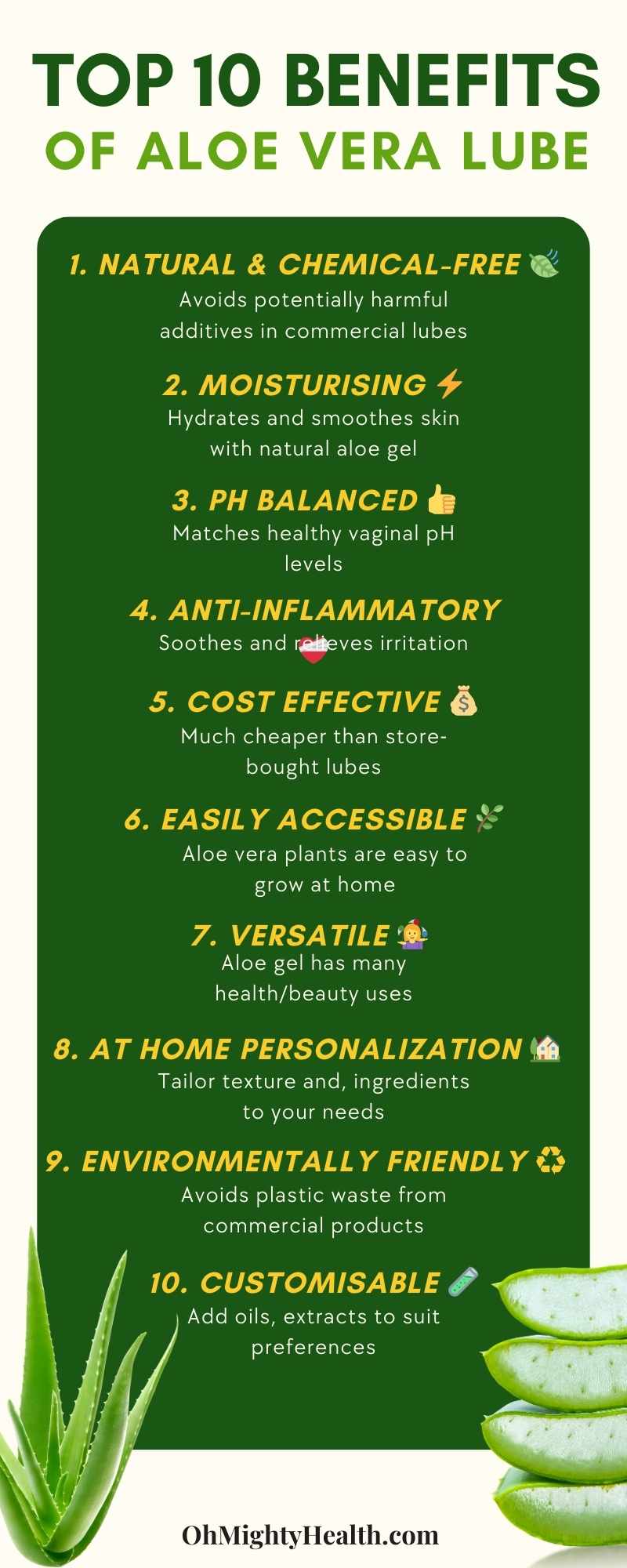
1. Natural and Chemical-Free
Using aloe vera as homemade lube means you’re harnessing the power of a pure plant extract, devoid of the potentially harmful additives, parabens, and synthetic scents that some shop-bought lubricants might contain. This is especially beneficial for those who have delicate skin or specific allergies.
2. Moisturising Properties
Recognised for its hydrating and calming effects, aloe vera can effectively minimise friction, offering a seamless and slippery experience, making it apt for personal moments.
The aloe vera gel lube can provide moisturising properties (aloevera gel as lube acts as a natural moisturiser).
In addition to its hydrating qualities, aloe vera is also appreciated for being soluble, ensuring easy application and cleanup.
In a 2023 study it was found that nano-exosomes derived from Aloe vera bark callus significantly improved skin surface, hydration, and elasticity.
3. Cost-Effective
Crafting your aloe vera-based lube can be more wallet-friendly than opting for off-the-shelf options, particularly if you’re cultivating an aloe vera plant in your space.
4. Anti-inflammatory Benefits
The inherent anti-inflammatory traits of aloe vera can be a boon for calming any skin irritation and diminishing redness.
In a 2022 study, it was found that Aloe vera has anti-inflammatory effects beneficial for alleviating skin irritation and reducing redness, particularly in lactating women experiencing nipple pain.
5. pH Balanced
The pH spectrum of aloe vera mirrors the inherent pH of the vaginal environment, ensuring that its use as a lubricant doesn’t upset the natural equilibrium.
However, for those attempting to conceive, it’s important to know that the fluctuating pH levels of cervical mucus during ovulation may not align well with aloe vera’s pH, potentially affecting its suitability. Source.
6. Easily Accessible
Cultivating aloe vera at home is a breeze, and its gel variant is a staple in many retail outlets. This ensures that you always have the primary ingredient on hand for your DIY lube.
7. No Harmful Side Effects
Given its organic nature, aloe vera is less prone to trigger any undesirable reactions, especially when juxtaposed with certain commercial alternatives.
8. Versatility
Beyond its role as a lubricant, the multifaceted aloe vera gel can be a go-to for skincare routines, aiding in healing minor injuries, and offering relief from sunburn.
Aloe vera gel is one of the most versatile natural products, easily adaptable for various health and beauty applications.
This 2023 review talks about how Aloe vera’s multifaceted nature allows it to be used for skincare routines, offering relief from sunburn, and aiding in the healing of minor injuries.
9. Environmentally Friendly Lubricant
Embracing the DIY route means fewer plastic containers, which is a nod towards a greener planet.
10. At Home Personalisation
The natural lubricant DIY approach allows you to tweak the texture and even infuse other organic elements, like aromatic oils, to your liking.
However, a word of caution: while aloe vera is generally deemed safe for topical applications, it’s prudent to conduct a preliminary skin test before its intimate use to rule out any allergic reactions. Moreover, if you’re relying on condoms, make sure that your homemade aloe vera lube won’t compromise the condom’s integrity. If in doubt seek advice from a medical expert.
On using saliva as natural lube:
While some individuals might consider using saliva as a quick alternative, it’s important to note that saliva, though readily available, is not an ideal lubricant as it can transmit STIs, disrupt the vaginal microbiome, and lacks the necessary properties for effective lubrication. Source.
Concerns with store-bought lubricants
Many store-bought lubricants contain chemicals and artificial ingredients that can cause irritation and discomfort. Some may even contain glycerin, which can increase the risk of yeast infections for some people (a 2013 study found that many unregulated sexual lubricants can harm the rectal lining and increase HIV risk due to their high osmolality and glycerin content).
Additionally, these products may not be as effective in providing long-lasting lubrication or hydration. It’s important to read the labels carefully and choose a product that is compatible with your body and personal preferences.
By making your own aloe vera lube, you have more control over the ingredients, ensuring a natural and gentle option that serves as an effective DIY personal lubricant.
DIY Aloe Vera Lube and Store-Bought Lubricants
| Factor | DIY Aloe Vera Lube | Store-bought Lubricants |
|---|---|---|
| Ingredients | Aloe vera gel, natural oils like vitamin E or jojoba oil | Water, glycerin, parabens, synthetic fragrances |
| Cost | Low, using homemade aloe gel and oils | Varies, typically $10-$30 |
| Shelf Life | 3-4 days refrigerated | 1-5 years unopened |
| Irritants | Low risk with pure ingredients | Higher risk with additives |
| pH Balance | Balanced like healthy vaginal pH | Often unbalanced pH |
| Condom Safe | Depends on oils used, oil degrades latex | Usually safe, but check labels |
| Texture | Natural gel-like | Variety of textures |
| Flavors/Scent | Natural subtle scent | Artificial fragrances added |
| Customizable | Highly, choose own oils/extracts | Not customisable |
Storage Tips
1. Refrigeration
Storing your aloe vera lube in the fridge is a surefire way to prolong its freshness. The cooler environment preserves its natural components and deters bacterial activity. You need to use a refrigerator to keep the aloe vera lube fresh.
2. Use Clean Utensils
Ensure your hands and tools are spotless whenever you prepare or apply the lube. Introducing contaminants can diminish its longevity.
3. Airtight Containers
Opt for containers that seal tightly, keeping air and external particles at bay, which can help maintain the lube’s integrity.
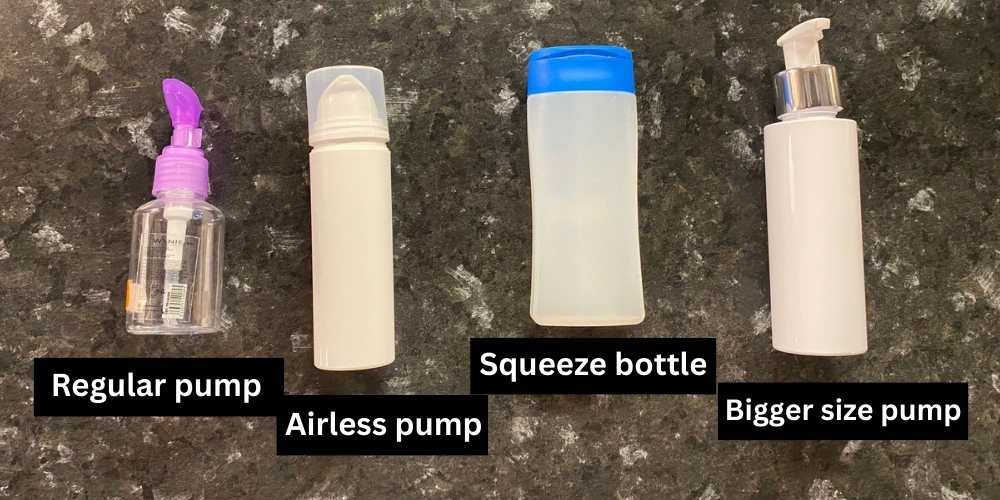
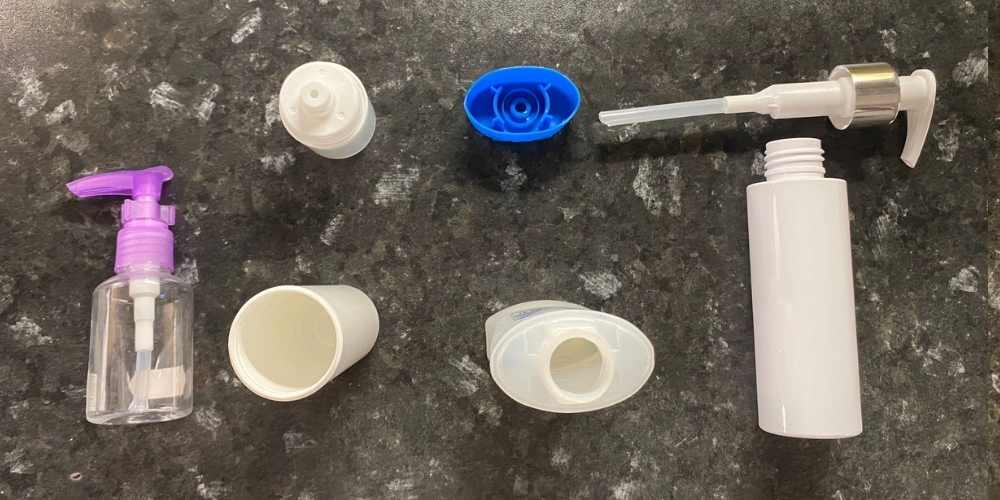
Your DIY lube can be conveniently stored in regular pump bottles, airless pumps, and squeeze bottles. The image above will give you a good idea of where to store your DIY lube.
Among these, airless pump containers are particularly effective in extending the shelf life of your homemade lube. By preventing air from entering the container, airless pumps help maintain the freshness and integrity of the lube for a longer period.
When stored in an airless pump, your DIY aloe vera gel-based lube can typically remain usable for 6-8 days, provided it’s kept in a cool, dark place. This significantly improves over the usual 3-4 days of shelf life when stored in standard containers.
I always store my DIY aloe vera gel in the refrigerator to preserve its freshness and extend its shelf life, ensuring it remains effective and safe.
4. Avoid Water Contamination
When accessing the lube, be vigilant about not introducing moisture. Even a small amount of water can pave the way for bacteria, shortening its lifespan.
5. Natural Preservatives
While they aren’t full-fledged preservatives, some people might suggest ingredients like Vitamin E and Jojoba oil as they can offer some protective antioxidant qualities. For a more robust preservation approach, others consider integrating grapefruit seed or rosemary oil extract, but you always need to verify their suitability for intimate areas. That’s why I prefer to freeze the lube in small cubes and use it as needed.
Check my video below on DIY aloe lube and preservation. I also look at what happens to the lube after two days in the fridge without preservation.
6. Small Batches
Crafting lube in modest quantities ensures you’re consistently using a fresher mix, reducing the risk of spoilage.
7. Check Consistency and Smell
Prior to application, give the lube a quick visual and olfactory inspection. Any unusual odours or alterations in texture could indicate it’s time for a new batch.
I’ve encountered unexpected challenges with DIY skincare, like discovering mould or encountering off-putting odours upon opening a jar. It’s crucial to stay alert and regularly check your homemade products to ensure they remain safe and pleasant.
8. pH Balance
Upholding an appropriate pH level can act as a barrier against bacterial proliferation. Using pH strips (I may earn a commission if you purchase from my link) can help monitor this. Ideally, it should align with the vaginal environment’s natural pH, hovering between 3.8 and 4.5.
9. Avoid Cross-Contamination
If you’re blending in oils or other elements, double-check their storage conditions and purity to ensure they don’t compromise the lube’s quality.
10. Date the Container
A simple yet effective tip – label your container with the preparation date. This acts as a reminder to use the lube within its optimal period.
Despite these precautions, your aloe vera lube won’t match the shelf life of commercially produced counterparts. It’s advisable to use it swiftly and remain alert for any signs of degradation.
Shelf Life Indicators in a Nutshell
While homemade aloe vera lube is a natural and gentle option, it’s essential to know when it’s past its prime. Here are some signs that your DIY lube might be due for a fresh batch:
- Change in Smell: If there’s a peculiar or rancid scent emanating from the lube, it’s a sign that it’s no longer at its best. (Explained in my video above).
- Altered Texture: Should the lube display a consistency that’s either too runny, overly thick, or has visible separation, it’s advisable to replace it. (Explained in my video above).
- Discolouration: Any shifts in hue, particularly towards a darker or yellowish shade, are red flags. (Explained in my video above).
- Skin Irritation: Experiencing unexpected tingling, redness, or itchiness upon application? It’s time to reconsider its use.
- Mould or Bacteria: If you spot any mould specks or notice a bubbly texture, it’s indicative of microbial growth and a cue to discard. (Explained in my video above).
For the best experience, always rely on your observations and instincts. If something seems off, it’s prudent to create a fresh mixture.
Safety Precautions
Embarking on the DIY lube journey is intriguing, but prioritising safety is essential. Here are some guidelines to navigate this venture safely:
- Patch Testing: Before widespread use, always apply a tiny amount on a discreet skin area. Monitor for any reactions over a 24-hour span.
- Ingredient Quality: Choose pristine, preferably organic, ingredients. This approach reduces the chances of encountering harmful substances that might be detrimental to the skin.
- Know Your Allergies: You have to familiarise yourself with your personal allergens. If you have known sensitivities, especially to botanicals or oils, scrutinise the components meticulously.
- Consultation: When uncertain, especially for those with prior skin issues, seeking guidance from a skin specialist or medical practitioner is recommended before extensive application.
- Expiration: Since DIY concoctions lack official expiry labels, be vigilant. Any shifts in odour, consistency, or look signal it’s time for a new mix. More on this below.
By adhering to these precautions, you can enjoy the benefits of your DIY aloe vera lube while ensuring safety and peace of mind.
Personal Lubricant Recipes for Your Aloe Vera Lube DIY
1. Lavender Essential Oil
Lavender isn’t just for relaxation. Its gentle aroma can be a delightful addition to your DIY lube recipe. Besides its fragrance, lavender has properties that can calm the skin.
Opt for a high-quality, therapeutic-grade oil and use sparingly to ensure the scent isn’t overpowering. 2-4 drops for one small aloe vera leaf is enough.
Try a small patch test of the final formula on your forearm and leave for 24 hours before applying it to more intimate areas.
2. Coconut Oil
A favourite in many skincare routines, coconut oil can add a touch of luxurious moisture to your lube. Its subtle tropical scent can also enhance the sensory experience. However, if you’re using latex condoms, be cautious, as coconut oil can weaken latex.
Coconut oil contains long-chain fatty acids that provide moisturising properties.
When to Add: Mix in the coconut oil with the aloe vera gel during the blending process for a uniform consistency.
How Much: Start with a teaspoon and adjust based on desired consistency and feel. If using with latex condoms, remember to exercise caution due to potential compatibility issues.
3. Chamomile Extract
For those who want a hint of tranquillity in their lube, chamomile extract can be the answer. Apart from its serene scent, it offers properties that can help alleviate skin discomfort.
When to Add: Incorporate the chamomile extract after blending the aloe vera gel, ensuring it’s evenly distributed throughout the mixture.
How Much: A few drops should suffice. Adjust based on scent preference and desired soothing effect.
Try a small patch test of the final formula on your forearm and leave for 24 hours before applying it to more intimate areas.
4. Rose Water
Introduce a romantic, floral note to your lube with a few drops of rose water. Beyond its fragrance, rose water can help soothe the skin, making it a dual-purpose addition.
When to Add: Blend in the rose water with the aloe vera gel to ensure a consistent aroma throughout the lube.
How Much: Depending on the desired fragrance intensity, start with a teaspoon and adjust as needed.
5. Almond Oil
Seeking a smoother glide? Almond oil can be your go-to. This lightweight oil not only enhances the texture of the lube but also nourishes the skin without being greasy.
When to Add: Combine the almond oil with the aloe vera gel during the blending phase for a seamless mixture.
How Much: Begin with a few drops and adjust based on the desired texture and feel. Always conduct a patch test first to rule out any allergic reactions.
**Be aware that some individuals may have nut allergies, so it’s essential to ensure it’s suitable for both partners.
6. Tea Tree Oil
For those who value the antiseptic qualities of tea tree oil, a drop or two can be integrated into the lube. Its distinctive aroma is potent, so it’s best to add it in moderation.
When to Add: Introduce the tea tree oil after blending the aloe vera gel, ensuring it’s well-distributed for maximum efficacy.
How Much: Given its potency, starting with a single drop is advisable. Adjust based on scent preference and desired antiseptic effect, but always use in moderation.
Try a small patch test of the final formula on your forearm and leave for 24 hours before applying it to more intimate areas.
7. Flaxseed Gel
If you want to naturally adjust your lube’s consistency, consider flaxseed gel. This gel not only acts as a thickener but also brings along benefits for the skin.
Making Flaxseed Gel at Home
Creating flaxseed gel is a straightforward process that requires minimal ingredients. Here’s a simple method:
- Ingredients: You’ll need 2 tablespoons of whole flaxseeds and 1 cup of water.
- Boiling: In a saucepan, combine the flaxseeds and water. Bring the mixture to a boil over medium heat.
- Simmering: Once boiling, reduce the heat and let it simmer. You’ll notice the water transforming into a gel-like consistency. This usually takes about 10-15 minutes.
- Straining: After achieving the desired consistency, remove the saucepan from heat. Strain the gel into a bowl or container using a fine mesh strainer or cheesecloth, separating the gel from the seeds.
- Cooling & Storing: Allow the gel to cool down to room temperature. Once cooled, transfer it to an airtight container and store in the refrigerator. It’s best used within 1 weeks.
This homemade flaxseed gel can be used as a natural thickener for your DIY aloe vera lube, and it also offers skin-nourishing benefits.
As you explore these alternative ingredients, it’s essential to conduct a skin test to rule out any sensitivities.
Always be informed about how your chosen ingredients might interact with protective barriers, such as condoms.
Aloe Natural Lubricant & Condom Compatibility
When using your DIY lube, especially one that incorporates oils, it’s crucial to understand its compatibility with condoms.
You need to check the condom label to ensure compatibility with the lube ingredients.
Here’s a more in-depth look at this aspect:
- Latex Condoms: Oils, including natural ones like coconut or almond oil, can degrade latex, weakening its structure. This can increase the risk of the condom tearing or breaking during use. If your lube contains oils, it’s best to avoid using it with latex condoms.
- Non-Latex Condoms: Condoms made from materials like polyurethane or polyisoprene are generally more resistant to oils. If you’re using a lube with added oils, these types of condoms are a safer bet.
- Natural Lambskin Condoms: While these condoms can be compatible with oil-based lubes, it’s essential to note that they don’t offer protection against STIs.
- Water-Based Lubes: If you’re concerned about condom compatibility, consider making a water-based lube variant. These are typically safe to use with all condom types.
- Check Labels: If you’re purchasing condoms, always read the label. Some might have specific recommendations or warnings regarding lubricant compatibility.
- Patch Test: If you’re unsure about the compatibility, you can do a patch test. Apply a small amount of lube to the condom and check for any reactions or weakening of the material.
- Consultation: When in doubt, seeking advice from a sexual health professional or pharmacist can provide clarity on the best condom and lube combinations.
Being informed about condom compatibility ensures not only a pleasurable experience but also a safe one, reducing the risk of unwanted surprises.
My Recommended Commercial Aloe Vera Lube
If you are not in the mood for making your own aloe vera lube or don’t have access to the leaves or plant, here is my next best recommendation (I may earn a commission if you buy from my link).
I absolutely love the ingredients that Aloe Cadabra contains:
Organic aloe vera gel, vitamin E oil, xanthan gum (natural thickener), citric acid (for pH balance), potassium sorbate (gentle, food grade preservative), sodium benzoate (gentle, food grade preservative), organic vanilla essential oil.
Perfect!
When combined, these powerful yet gentle, food-grade ingredients create a lube that moisturises, protects, and nourishes delicate tissue while providing slick glide.
The botanical ingredients like aloe and vanilla oil give this formula an organic, therapeutic sensuality.
It’s natural lubrication you can trust.
Conclusion
Embracing the natural wonders of aloe vera for intimate care is not just a nod to holistic health but also a testament to the plant’s multifaceted benefits.
Making your own aloe vera lube is not just about harnessing nature’s gifts, but also about ensuring a tailored and safe experience.
By choosing this DIY route, you’re prioritising your comfort and steering clear of the uncertainties that come with some commercial products.
The process of crafting this lube is as enlightening as its application, fostering a deeper connection with your body and its needs.
So, when you think of reaching for a lubricant next time, let it be your bespoke blend, infused with the purity and care of aloe vera.
FAQs
Q: Can you use aloe vera as lube?
You might be asking “can aloe vera be used as lube”? The answer is yes, aloe vera makes an excellent DIY lube! The plant is known for its hydrating properties and gentle touch, making it an excellent choice.
Q: Is it safe for all skin types?
Generally, aloe vera is gentle and suitable for most skin types. However, if you have sensitive skin or known allergies, it’s always best to conduct a patch test before widespread use.
Q: How long does homemade aloe vera lube last?
When stored correctly in the refrigerator, it’s best to use the lube within 3-4 days. If you notice any changes in smell, texture, or appearance, it’s time to make a fresh batch.
Q: Can I use it with toys?
Yes, aloe vera lube is typically safe to use with most toys. However, if your lube contains oils, ensure that it’s compatible with the material of your toy, especially if it’s made of silicone.
Q: Are there any side effects of using aloe vera lube?
Aloe vera is generally safe for topical use. However, some individuals might experience irritation or an allergic reaction. It’s always recommended to do a patch test first.
Q: Can I use this lube orally?
If you’re using 100% pure aloe vera and natural ingredients without any additives, it’s generally safe for oral use. However, always ensure the ingredients you add are edible.
Q: How does it compare to store-bought versions?
Homemade aloe vera lube is natural, free from chemicals, and can be customised to your preference. Store-bought versions might have a longer shelf life due to preservatives but could contain additives or ingredients that some people wish to avoid.
Q: Can I add flavour to my aloe vera lube?
Yes, you can infuse your lube with edible essential oils or natural extracts for flavour. Ensure any added ingredients are safe for internal use.
Q: Is it safe during pregnancy?
Always consult with a healthcare professional before using any new products during pregnancy.
Q: Can I use other plants or natural gels as a base for lube?
While aloe vera is a popular choice due to its soothing properties, there are other natural gels like flaxseed gel that can be used. Always research and ensure any alternative is safe for intimate use.
Q: What if my lube feels too thick or thin?
The consistency can be adjusted based on personal preference. If it’s too thick, you can add a few drops of distilled water or a lightweight oil. If too thin, consider adding more aloe vera gel or flaxseed gel.
Q: What works best as a natural lubricant for sensitive skin?
For sensitive skin, a natural lubricant like aloe vera gel works best. Its gentle and hydrating properties make it ideal for those with skin sensitivities.
Q: Can you share a simple recipe for aloe-based lube?
Absolutely! A basic recipe involves blending fresh aloe vera gel with a few drops of Vitamin E or Jojoba oil for added moisture. Ensure the aloe vera is pure and free from additives for the best results.
Q: How do you use a homemade aloe vera lube effectively?
To use a homemade aloe vera lube, apply it generously to the desired area. If you’re using it with toys or condoms, check for compatibility, especially if oils are added to the mix.
Q: What are the best ingredients to add to an aloe-based lube for enhanced comfort?
For enhanced comfort, consider adding natural moisturizers like Vitamin E or Jojoba oil to your aloe-based lube. These ingredients can improve the lubricant’s texture and moisturizing properties.
Q: Is there a specific aloe vera variety that works best for DIY lube?
Any pure, organic aloe vera gel works well for DIY lube. The key is to ensure it’s free from alcohol, fragrances, and other additives that might cause irritation.
Our Commitment to Accuracy
Upholding trust through rigorous content review.
Correction Log
None to date.
Fact-Checked & Verified
At ohmightyhealth.com, we are committed to providing accurate and trustworthy information. Each article undergoes a rigorous review process to ensure its content reflects the best available information at the time of publication.
Article Review Details
- Date of Review: 9th November 2023
- Reviewed By: María Candelaria Coto González, B.Sc.
- Credentials: Bachelor’s in Chemistry
- Experience: Chemistry teacher for the generic Secondary Education Institutes of the Canary Islands Government programme for 33 years. 1, 2
Disclaimer
Our editorial team reviewed this article for accuracy and thoroughness. However, it’s important to understand that the content reflects the best information available at the time of publication and should not be used as a substitute for professional advice or judgment.
Cross-Referencing
Our content is cross-referenced with multiple sources to ensure accuracy and reliability.
Feedback & Corrections
We value our readers’ insights and encourage you to leave comments or feedback. If you notice any inaccuracies or have additional insights to offer, please let us know. Your feedback helps us uphold the highest standards of content quality.
Learn More About Our Editorial Standards
For a deeper understanding of our commitment to editorial integrity, you can visit our Editorial Process and Editorial Principles.
References
- Al-Nima AM. Preparation and Evaluation of Topical Gel Containing Aloe Vera Exudate. Iraqi Journal of Pharmacy [Internet]. 2022 [cited 2023 Sep 2]; 18(2):39–52. Available from: https://iphr.mosuljournals.com/article_170396.html.
- Kim D-M, Kim W-J, Lee H-K, Kwon Y-S, Choi Y-M, Kim D-M, et al. Skin Improvement of the Composition Containing Nano-exosome Derived from Aloe vera Bark Callus as New Type of Transdermal Delivery System. Asian J Beauty Cosmetol [Internet]. 2023 [cited 2023 Sep 2]; 21(1):117–30. Available from: http://www.e-ajbc.org/journal/view.php?doi=10.20402/ajbc.2023.0004.
- Maleki A, Youseflu S. The Effectiveness of Aloe Vera on Relief of Irritation and Nipple Pain in Lactating Women: Systematic Review and Meta-Analysis. Obstetrics and Gynecology International [Internet]. 2022 [cited 2023 Sep 2]; 2022:e7430581. Available from: https://www.hindawi.com/journals/ogi/2022/7430581/.
- Lin Y-P, Chen W-C, Cheng C-M, Shen C-J. Vaginal pH Value for Clinical Diagnosis and Treatment of Common Vaginitis. Diagnostics (Basel) [Internet]. 2021 [cited 2023 Sep 2]; 11(11):1996. Available from: https://www.ncbi.nlm.nih.gov/pmc/articles/PMC8618584/.
- Zagórska-Dziok M, Furman-Toczek D, Dudra-Jastrzębska M, Zygo K, Stanisławek A, Kapka-Skrzypczak L. Evaluation of clinical effectiveness of Aloe vera – a review. J Pre Clin Clin Res [Internet]. 2017 [cited 2023 Sep 2]; 11(1):86–93. Available from: https://www.jpccr.eu/Evaluation-of-clinical-effectiveness-of-Aloe-vera-a-review,74577,0,2.html.

